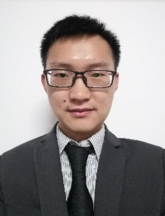12 May
2021
Online seminar by former graduate Dr Wu Zhenghui
Online via Zoom
11:00am - 12:00pm
Abstract
Our former graduate student Dr Wu Zhenghui will come to Hong Kong and give an online seminar, the details is listed as follows:
Topic: Carrier and Exciton Dynamics and Their Impacts in Novel Optoelectronic Devices
Speaker: Dr Wu Zhenghui
Department of Electrical and Electronic Engineering
Southern University of Science and Technology, Shenzhen, China
Moderator: Prof Furong Zhu
Date: May 13, 2021 (Thursday)
Time: 11:00am – 12:00noon
Join Zoom Meeting
Meeting ID: 977 1114 6115
Download the Poster
Abstract:
Infrared photodetectors are essential to many applications including surveillance, communications, and biological imaging. The shortwave infrared spectral region (SWIR: 1-3 m) is particularly powerful for health monitoring and medical diagnostics. However, current SWIR photodetection technologies are largely based on epitaxial grown inorganic semiconductors that are costly, require complex processing. Organic semiconductors are being developed for infrared detectors to enable low-cost direct deposition, conformal coverage, and facilitate monolithic integration and resolution not achievable by using current technologies. Due to its compatibility with the substrates, SWIR photodetector is usually integrated with a quantum-dot light-emitting diode (QLED) to form an up-conversion device and display the SWIR signal directly. Understandings on carrier and exciton dynamics in SWIR photodetector and QLEDs are essential for improving their efficiencies and stabilities.
Our recent efforts to understand and improve the performances of organic SWIR photodetectors and QLEDs are introduced. First, we discuss the main bottlenecks associated with fast recombination of excitons and carriers, which are more challenging to address in narrow bandgap photodetectors in comparison to devices operating in the visible to NIR. Based on our understanding of loss mechanism, detectivity exceeding 1011 Jones, comparable to commercial germanium photodiodes, was achieved by using high dielectric additive. The high dielectric additive was shown to enhance both dissociation and charge transport, and be able to engineer the electronic properties of the photoactive layer. Second, we call attention to discrepancies in the literature regarding performance metrics. We share our perspective on potential pitfalls that may lead to over-estimated values, with particular attention to the thermal noise and detectivity, in order to ensure a fair comparison of device performance. We also elaborate the limiting factors on the generation of intrinsic carriers and thermal noise, including effective bandgap and energetic disorder of localized states at the band edges in organic SWIR photodetectors. Third, the carrier dynamics at the interface between quantum dot emissive layer and electron transport layer are discussed to understand the performance enhancement and aging characteristics in QLEDs.
You May Also Like...
All Events19 Oct
2023



